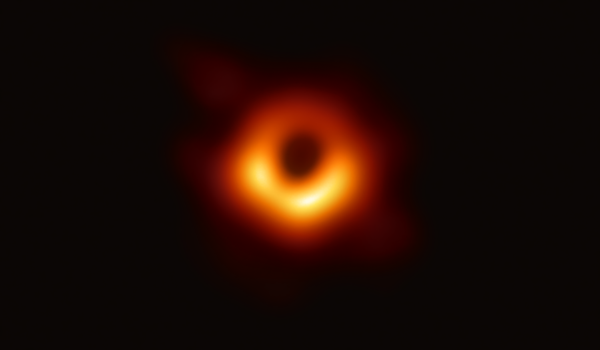The Event Horizon Telescope (EHT) team took humanity to the heart of darkness when it unveiled the world’s first direct image of a black hole in April. That feat has now earned the team one of this year’s six US$3-million Breakthrough prizes—the most lucrative awards in science and mathematics.
The image shows the supermassive black hole at the centre of the galaxy Messier 87, which lies around 17 parsecs (55 million light years) from Earth. A ring of light is seen skirting the black hole’s event horizon—the surface of no return, beyond which the pull of gravity is so strong that not even light can escape its clutches. The light in the ring is generated by hot matter as it crosses the event horizon. It defines a circular silhouette that represents the black hole itself.
“Two decades ago, we set out to see the unseeable and it paid off in spectacular fashion,” says EHT director Shep Doeleman, an astrophysicist at Harvard University in Cambridge, Massachusetts. “It’s an amazing feeling to be given this award.”
On supporting science journalism
If you're enjoying this article, consider supporting our award-winning journalism by subscribing. By purchasing a subscription you are helping to ensure the future of impactful stories about the discoveries and ideas shaping our world today.
“This was the first time we’d seen these truly bizarre and extreme objects with our own eyes,” says Katie Mack, an astrophysicist at North Carolina State University in Raleigh, who is not part of the EHT collaboration. “It’s just really cool!” she adds.
Constructing the image was an immense coordinated effort. The EHT team made simultaneous observations on eight telescopes around the world, synchronized by atomic clocks to an accuracy of better than one second in 100 million years. This effectively created an Earth-sized telescope powerful enough to image the black hole. Doeleman recalls how risky it was in the early days: “We went out to telescopes, sweated blood and sometimes came back empty-handed.”
The prize will be shared equally between the 347 members of the collaboration, and will be awarded at a ceremony at NASA’s Ames Research Center in Mountain View, California, on 3 November. In 2012, Russian–Israeli billionaire Yuri Milner founded the Breakthrough prizes; and they are now sponsored by him and other Internet entrepreneurs, including Facebook chief Mark Zuckerberg and Google’s Sergei Brin.
Life-sciences prizes
Four Breakthrough prizes were awarded in the life sciences. Jeffrey Friedman, a geneticist at the Rockefeller University in New York City, was recognized for discovering the hormone leptin, which signals the brain to regulate appetite and makes us feel full. He recalls “feeling weak at the knees” when, in 1994, after an eight-year effort, his team successfully cloned a defective version of the gene that encodes leptin in obese mice. “It was incredibly exciting to learn about the prize,” he says.
“Friedman’s discovery was seminal—opening the floodgates to decades of discoveries on appetite,” says Jane Howard, an endocrinologist at King’s College London who has investigated how reduced leptin levels caused by starvation can compromise immune systems. Although body weight seems to be regulated by a complex mix of genes and environmental factors, Friedman’s insight that a single gene can have a profound effect on the body changed scientists’ attitudes towards obesity, she says.
Virginia Man-Yee Lee, of the University of Pennsylvania in Philadelphia, was awarded a Breakthrough Prize for her work examining the way in which proteins can become tangled in brain cells. These tangles have been implicated in neurodegenerative diseases such as Alzheimer’s, Parkinson’s and motor-neuron disease (amyotrophic lateral sclerosis). Lee says receiving the award is an “unexpected and pleasant surprise”.
Ulrich Hartl of the Max Planck Institute in Munich, Germany, and Arthur Horwich, of Yale University in New Haven, Connecticut, won a life-sciences prize for their work explaining how ‘chaperone molecules’ help proteins fold into precise 3D shapes. Another award went to David Julius, of the University of California, San Francisco, for discovering the molecular mechanisms that underlie pain sensations.
Magic wands and supergravity
The Breakthrough Prize in mathematics was given to Alex Eskin of the University of Chicago in Illinois. Together with the late Iranian Fields Medal-winning mathematician Maryam Mirzakhani, he tackled the ‘billiard ball problem’, which considers the possible paths a ball will take as it bounces around polygonal billiard tables. This led the pair to derive a ‘magic wand theorem’ in 2013, given this name because it brings together aspects of topology, dynamical systems and geometry to easily solve many previously stubborn mathematics problems.
The announcements follow one in August, when the Breakthrough selection committee awarded a special prize in physics to particle physicists Sergio Ferrara of CERN—Europe’s high-energy physics lab near Geneva, Switzerland—Daniel Freedman of the Massachusetts Institute of Technology in Cambridge and Peter van Nieuwenhuizen of Stony Brook University in New York. The trio developed ‘supergravity’—a speculative but highly influential attempt to unify all the forces of nature in one theory—in the 1970s.
This article is reproduced with permission and was first published on September 5, 2019.
